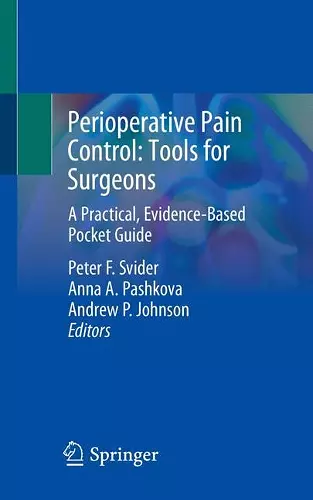Perioperative Pain Control: Tools for Surgeons
A Practical, Evidence-Based Pocket Guide
Andrew P Johnson editor Peter F Svider editor Anna A Pashkova editor
Format:Paperback
Publisher:Springer Nature Switzerland AG
Published:22nd Jan '21
Currently unavailable, our supplier has not provided us a restock date

According to the Centers for Disease Control and Prevention (CDC), there were nearly 40,000 opioid-related deaths in the U.S in the last year alone. These numbers have increased considerably for a variety of reasons, and the growing role of prescription drug abuse has been widely recognized. There has also been increasing consciousness of the lack of dedicated and formalized training dedicated to prescription of analgesics, particularly among surgical trainees and practicing surgeons. Recent studies demonstrate that only a small minority of training programs mandates any opioid prescribing education, despite the fact that nearly all programs allow trainee prescription of opioids on an outpatient basis. Therefore, it is not surprising that despite a growing body of literature illustrating the value of opioid alternatives and adjuncts, practicing surgeons in all specialties largely ignore these evidence-based practices and continue to prescribe opioids in situations for which alternatives are proven, safe, and effective. There are many reasons for preparing a concise and practical resource describing evidence-based practices targeting surgeons and surgical subspecialists, including but not limited to: (1) The exponential increase in prescription drug abuse associated with the “opioid epidemic,” as surgeons play an important role in managing perioperative and chronic pain in a variety of practice setting; this issue bears importance from the patient, physician, and policymaker standpoint; (2) With increasing recognition of the role of quality improvement in patient safety initiatives, and literature demonstrating inadequate opioid prescribing education (OPE) in surgical training programs, it is only a matter of time before accreditation bodies including the ACGME incorporate strong recommendations and mandates for OPE; (3) Myriad literature demonstrating the existence of evidence-based alternatives to opioids – All surgeons and surgical subspecialists would benefit from a practical guide concisely laying this literature out. We feel that surgeons of all experience levels may benefit, ranging from the first year surgical intern to an experienced practitioner trying to remain compliant with the evolving opioid regulatory environment.
Hence, the appropriate target audience for this text would be for the tens of thousands of current surgical trainees in many specialties, including general surgery, thoracic surgery, otolaryngology, plastic surgery, urology, gynecology, vascular surgery, neurosurgery, and orthopedic surgery. Furthermore, surgeons out of training would be another audience of interest, as there are increasing courses for...
ISBN: 9783030560805
Dimensions: unknown
Weight: unknown
348 pages
1st ed. 2021